Experimental and Numerical Investigation on the Aerosol Micro-Jet 3D Printing of Flexible Electronic Devices
Abstract
:1. Introduction
2. Materials and Methods
2.1. Experimental Materials
2.2. Experimental Equipment
2.3. Experimental Methods
2.4. Result Characterization Processing
3. Results
3.1. Physical Model Analysis
3.2. Gas Flow Rate
3.3. Nozzle Diameter
3.4. Working Distance
3.5. Printing Speed
3.6. Printing of Flexible Circuit
3.7. Fabrication of Flexible Strain Sensors
4. Discussion
5. Conclusions
- (1)
- During the AMJP process, factors such as carrier gas flow rate, sheath gas flow rate, working distance, nozzle diameter, and printing speed had a significant impact on the minimum feature line width of the printed lines. The minimum feature line width gradually decreased with the increase in sheath gas flow rate and printing speed, while it gradually increased with the increase in carrier gas flow rate, working distance, and nozzle diameter.
- (2)
- A discrete phase simulation model was used to predict and optimize the effects of various parameters on the AMJP performance, providing guidance for practical operations. Additionally, through experimental studies, actual printing data were obtained, and the accuracy of the prediction results was validated.
- (3)
- Through single-factor experiments, it was determined that under a carrier gas flow rate of 100 sccm, sheath gas flow rate of 400 sccm, working distance of 3 mm, and nozzle diameter of 500 μm, the minimum feature line width of the printed lines could reach 43 μm, and there were no significant defects such as satellite droplets and deposition voids.
- (4)
- Based on the aforementioned process parameters, flexible strain sensors were fabricated on PDMS substrates, and these sensors were applied to detect mechanical deformations of human fingers. This verified the ability of the sensors to detect subtle changes in human motion, indicating their potential application in fields such as smart wearable devices.
Author Contributions
Funding
Institutional Review Board Statement
Informed Consent Statement
Data Availability Statement
Acknowledgments
Conflicts of Interest
References
- Khan, S.; Lorenzelli, L.; Dahiya, R.S. Technologies for printing sensors and electronics over large flexible substrates: A review. IEEE Sens. J. 2015, 15, 3164–3185. [Google Scholar] [CrossRef]
- Wilkindon, N.J.; Smith, M.A.A.; Kay, R.W.; Harris, R.A. A review of aerosol jet Printing-A Non-traditional hybrid process for micro-manufacturing. Int. J. Adv. Manuf. Technol. 2019, 105, 4599–4619. [Google Scholar] [CrossRef]
- Łapa, W.; Winnicki, M.; Orłowska, K. Investigation of aerosol droplets diameter generated in aerosol jet printing. Mater Sci. Pol. 2022, 40, 78–90. [Google Scholar] [CrossRef]
- Hines, D.R.; Gu, Y.; Martin, A.A.; Li, P.; Fleischer, J.; Clough-Paez, A.; Stackhouse, G.; Dasgupta, A.; Das, S. Considerations of aerosol-jet printing for the fabrication of printed hybrid electronic circuits. Addit. Manuf. 2021, 47, 102325. [Google Scholar] [CrossRef]
- Tsui, L.K.; Kayser, S.V.C.; Strong, S.A.; Lavin, J.M. High resolution aerosol jet printed components with electrodeposition-enhanced conductance. ECS J. Solid State Sci. 2021, 10, 047001. [Google Scholar] [CrossRef]
- Cao, C.Y.; Andrews, J.B.; Franklin, A.D. Completely printed, flexible, stable, and hysteresis-free carbon nanotube thin-film transistors via aerosol jet printing. Adv. Electron. Mater. 2017, 3, 1700057. [Google Scholar] [CrossRef]
- Zhu, Y.C.; Yu, L.K.; Wu, D.Z.; Lv, W.L.; Wang, L.Y. A high-sensitivity graphene ammonia sensor via aerosol jet printing. Sens. Actuators A Phys. 2021, 318, 112434. [Google Scholar] [CrossRef]
- Zhou, L.Y.; Gao, Q.; Zhan, J.F.; Xie, C.Q.; Fu, J.Z.; He, Y. 3D printed wearable sensors with liquid metals for the pose detection of snakelike soft robots. ACS Appl. Mater. Interfaces 2018, 10, 23208–23217. [Google Scholar] [CrossRef]
- Muth, J.T.; Vogt, D.M.; Truby, R.L.; Mengüç, Y.; Kolesky, D.B.; Wood, R.J.; Lewis, J.A. 3D printing: Embedded 3D printing of strain sensors within highly stretchable elastomers. Adv. Mater. 2014, 26, 6307–6312. [Google Scholar] [CrossRef]
- Fidan, I.; Huseynov, O.; Ali, A.M.; Alkunte, S.; Rajeshirke, M.; Gupta, A.; Hasanov, S.; Tantawi, K.; Yasa, E.; Yilmaz, O.; et al. Recent inventions in additive manufacturing: Holistic review. Inventions 2023, 8, 103. [Google Scholar] [CrossRef]
- Salary, R.; Lombardi, J.P.; Rao, P.K.; Poliks, M.D. Online monitoring of functional electrical properties in aerosol jet printing additive manufacturing process using shape-from-shading image analysis. J. Manuf. Sci. Eng. 2017, 139, 101010. [Google Scholar] [CrossRef]
- Davies, M.; Hobbs, M.J.; Nohl, J.; Davies, B.; Rodenburg, C.; Willmott, J.R. Aerosol jet printing polymer dispersed liquid crystals on highly curved optical surfaces and edges. Sci. Rep. 2022, 12, 18496. [Google Scholar] [CrossRef] [PubMed]
- Falina, S.; Anuar, K.; Shafiee, S.A.; Juan, J.C.; Manaf, A.A.; Kawarada, H.; Syamsul, M. Two-dimensional non-carbon materials-based electrochemical printed sensors: An updated review. Sensors 2022, 22, 9358. [Google Scholar] [CrossRef] [PubMed]
- Jing, Q.S.; Choi, Y.S.; Smith, M.; Ou, C.; Busolo, T.; Kar-Narayan, S. Freestanding functional structures by aerosol-jet printing for stretchable electronics and sensing applications. Adv. Mater. Technol. 2019, 4, 1900048. [Google Scholar] [CrossRef]
- Vlnieska, V.; Gilshtein, E.; Kunka, D.; Heier, J.; Romanyuk, Y.E. Aerosol jet printing of 3D pillar arrays from photopolymer ink. Polymers 2022, 14, 3411. [Google Scholar] [CrossRef] [PubMed]
- Mahajan, A.; Frisbie, C.D.; Francis, L.F. Optimization of aerosol jet printing for high-resolution, high-aspect ratio silver lines. ACS Appl. Mater. Interfaces 2013, 5, 4856–4864. [Google Scholar] [CrossRef] [PubMed]
- Seifert, T.; Sowade, E.; Roscher, F.; Wiemer, M.; Gessner, T.; Baumann, R.R. Additive manufacturing technologies compared: Morphology of deposits of silver ink using inkjet and aerosol jet printing. Ind. Eng. Chem. Res. 2015, 54, 769–779. [Google Scholar] [CrossRef]
- Salary, R.; Lombardi, J.P.; Weerawarne, D.L.; Rao, P.; Poliks, M.D. A computational fluid dynamics investigation of pneumatic atomization, aerosol transport, and deposition in aerosol jet printing process. J. Micro Nano-Manuf. 2021, 9, 4049958. [Google Scholar] [CrossRef]
- Chen, G.; Gu, Y.; Tsang, H.; Hines, D.R.; Das, S. The effect of droplet sizes on overspray in aerosol-jet printing. Adv. Eng. Mater. 2017, 20, 1701084. [Google Scholar] [CrossRef]
- Secor, E.B. Principles of aerosol jet printing. Flex. Print. Electron. 2018, 3, 035002. [Google Scholar] [CrossRef]
- Rurup, J.D.; Secor, E.B. Predicting deposition rate and closing the loop on aerosol jet printing with in-line light scattering measurements. Adv. Eng. Mater. 2023, 25, 2201919. [Google Scholar] [CrossRef]
- Salary, R.; Lombardi, J.P.; Tootooni, M.S.; Donovan, R.; Rao, P.K.; Borgesen, P.; Poliks, M.D. Computational fluid dynamics modeling and online monitoring of aerosol jet printing process. J. Manuf. Sci. Eng. 2017, 139, 201015. [Google Scholar] [CrossRef]
- Ryzhenkov, V.O.; Sozinov, D.A.; Mullyadzhanov, R.I. Effect of geometry on direct and adjoint linear global modes of low reynolds number laminar flow over body. J. Engin. Thermophys. 2021, 29, 576–581. [Google Scholar] [CrossRef]
- Wu, J.D.; Xu, J.Y.; Wang, H. Numerical simulation of aerosol dynamics in an impinging jet with microdroplet coalescence. Aerosol Sci. Technol. 2020, 54, 880–891. [Google Scholar] [CrossRef]
- Sebastian, B.; Markus, G.; Edda, R. Analytical investigation of aerosol jet printing. Aerosol Sci. Technol. 2014, 48, 924–929. [Google Scholar] [CrossRef]
- Mezhericher, M.; Stone, H.A. Possible, impossible, and expected diameters and production rates of droplets in aerosols and sprays. Phys. Rev. Fluids 2022, 7, 063602. [Google Scholar] [CrossRef]
- Ogazi, A.C.; Osifo, P.O. Dynamics of drop formation and characterization of additive manufactured CS/AgNP/PVA composite membranes. J. Appl. Polym. Sci. 2023, 39, e54472. [Google Scholar] [CrossRef]
- Cong, C.H.; Li, X.L.; Xiao, W.; Li, J.R.; Jin, M.L.; Kim, S.H.; Zhang, P.F. Electrohydrodynamic printing for demanding devices: A review of processing and applications. Nanotechnol. Rev. 2022, 11, 3305–3334. [Google Scholar] [CrossRef]

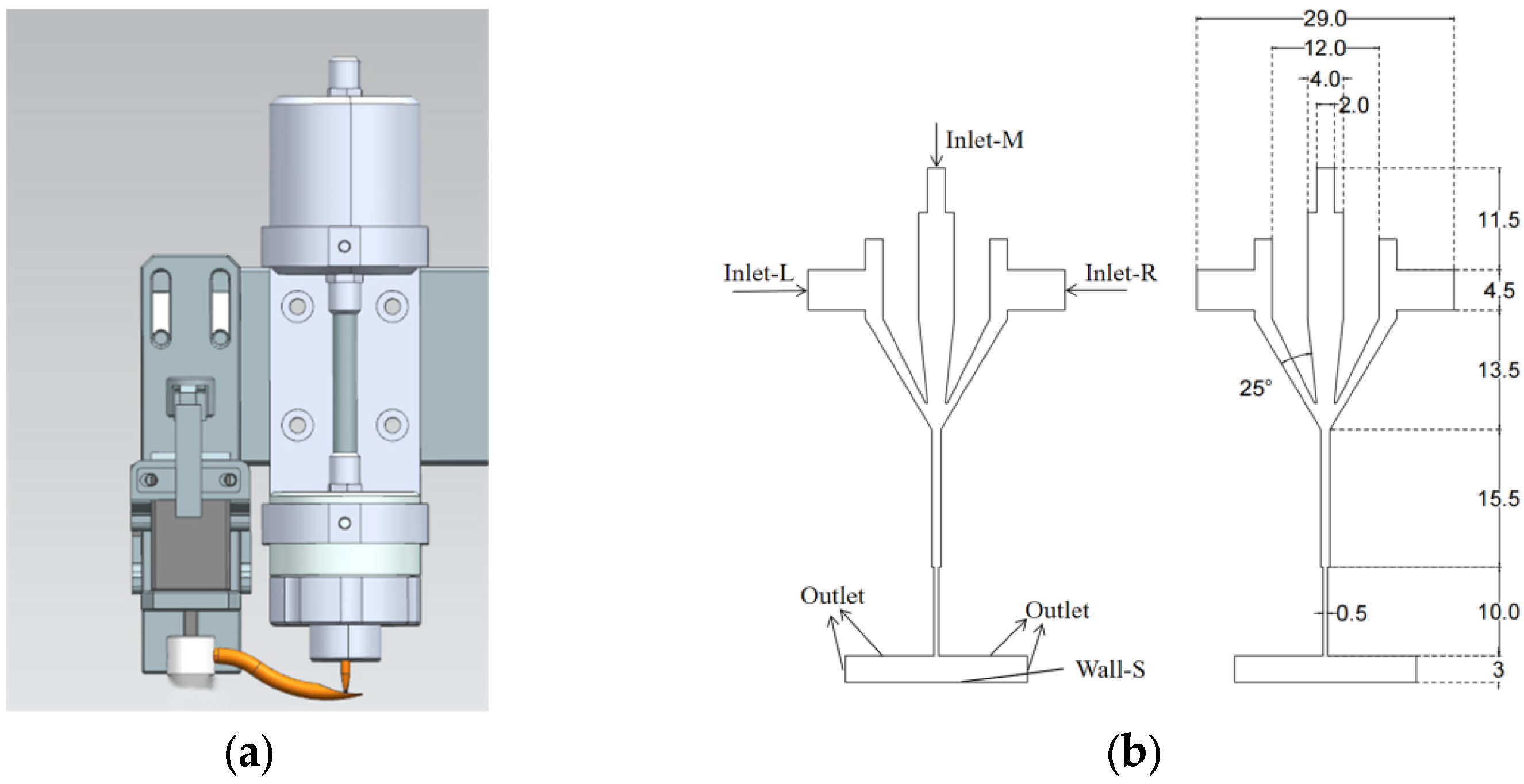

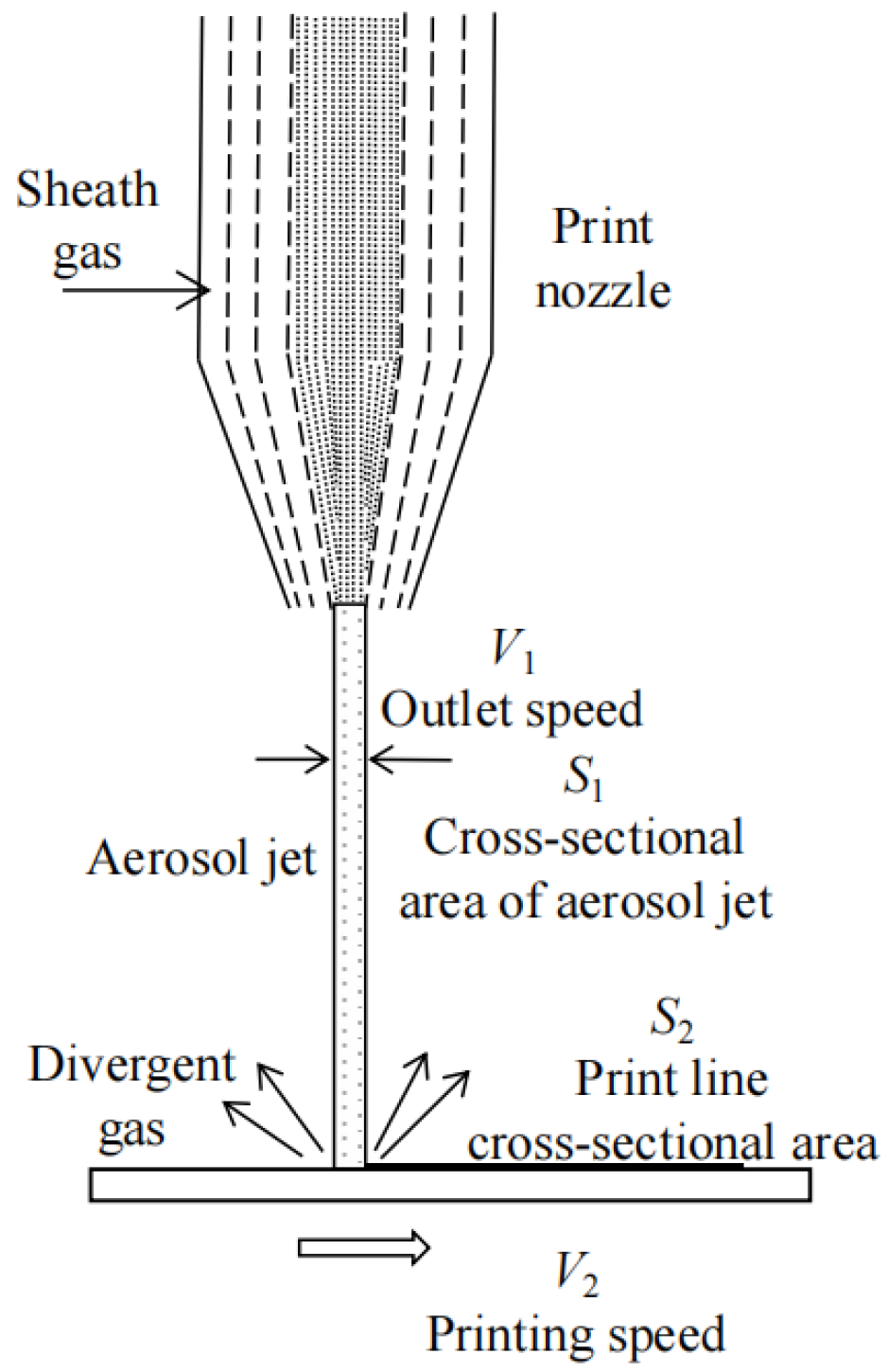
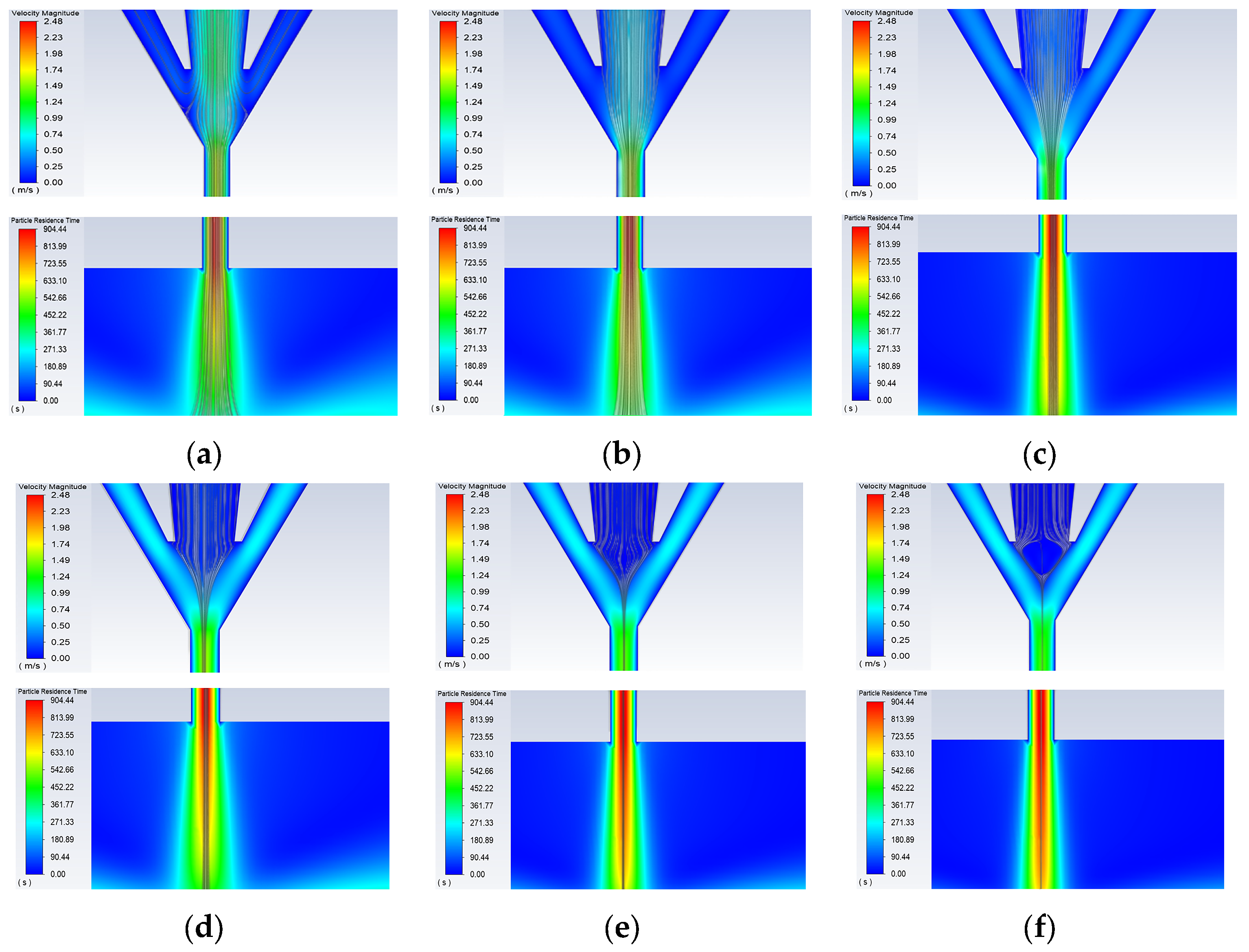
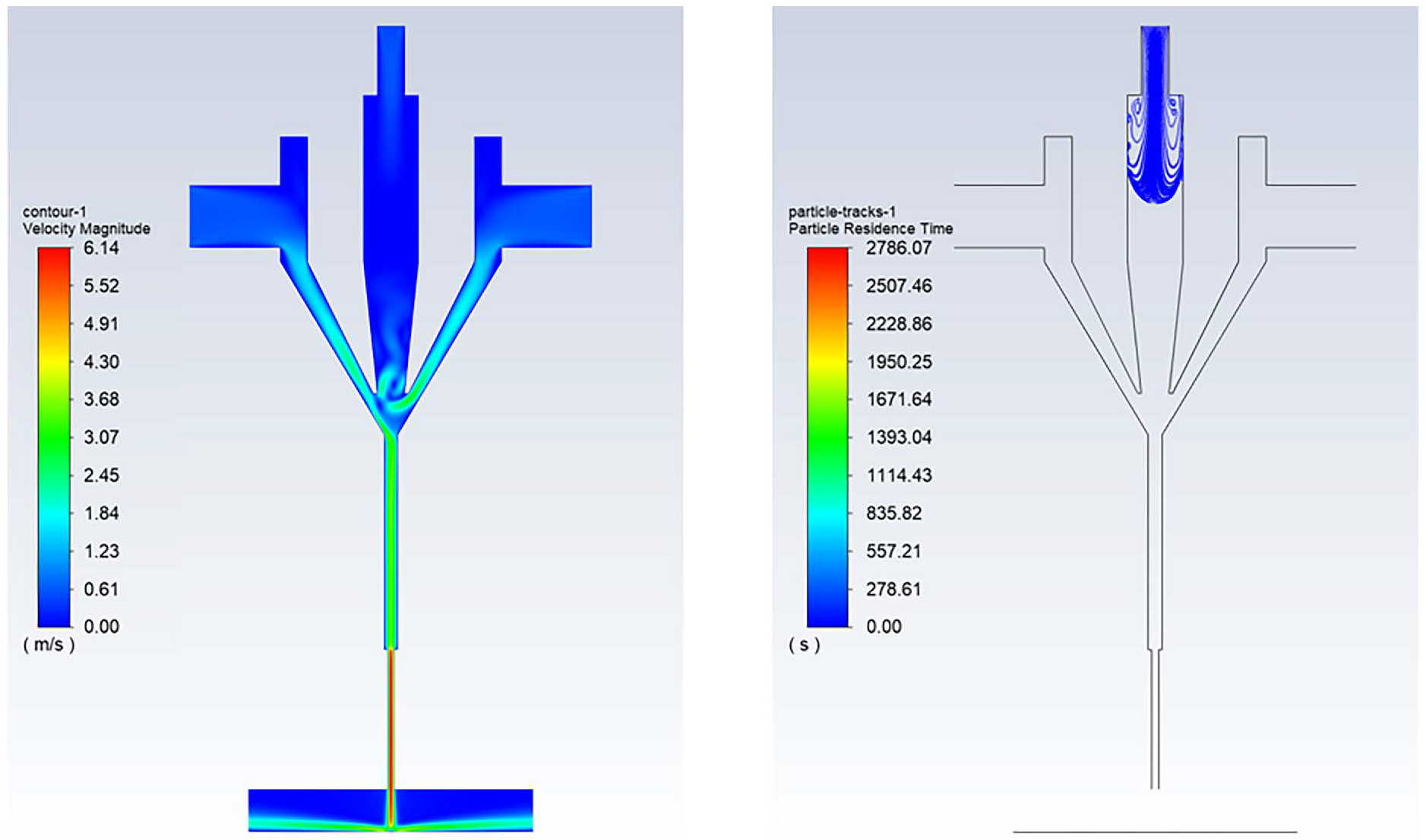
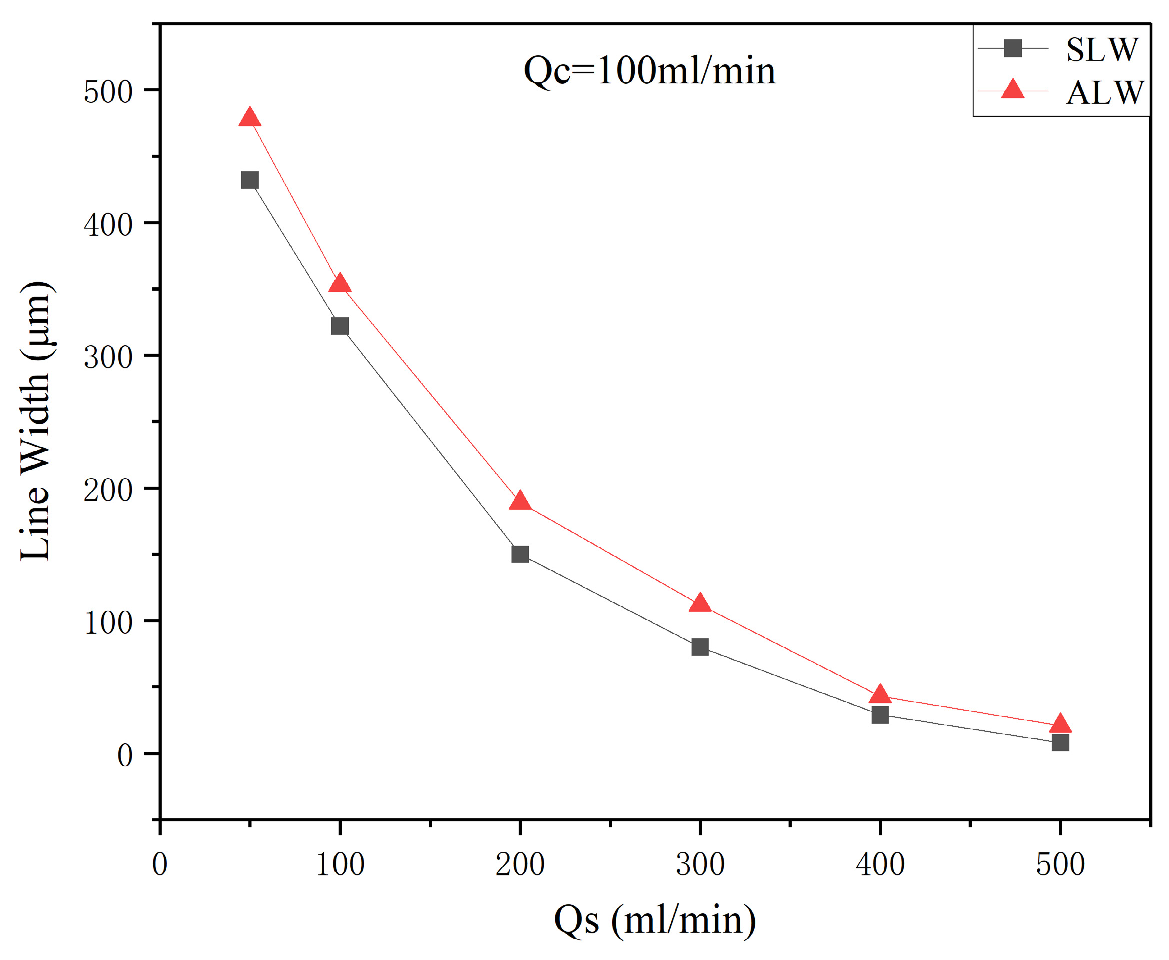
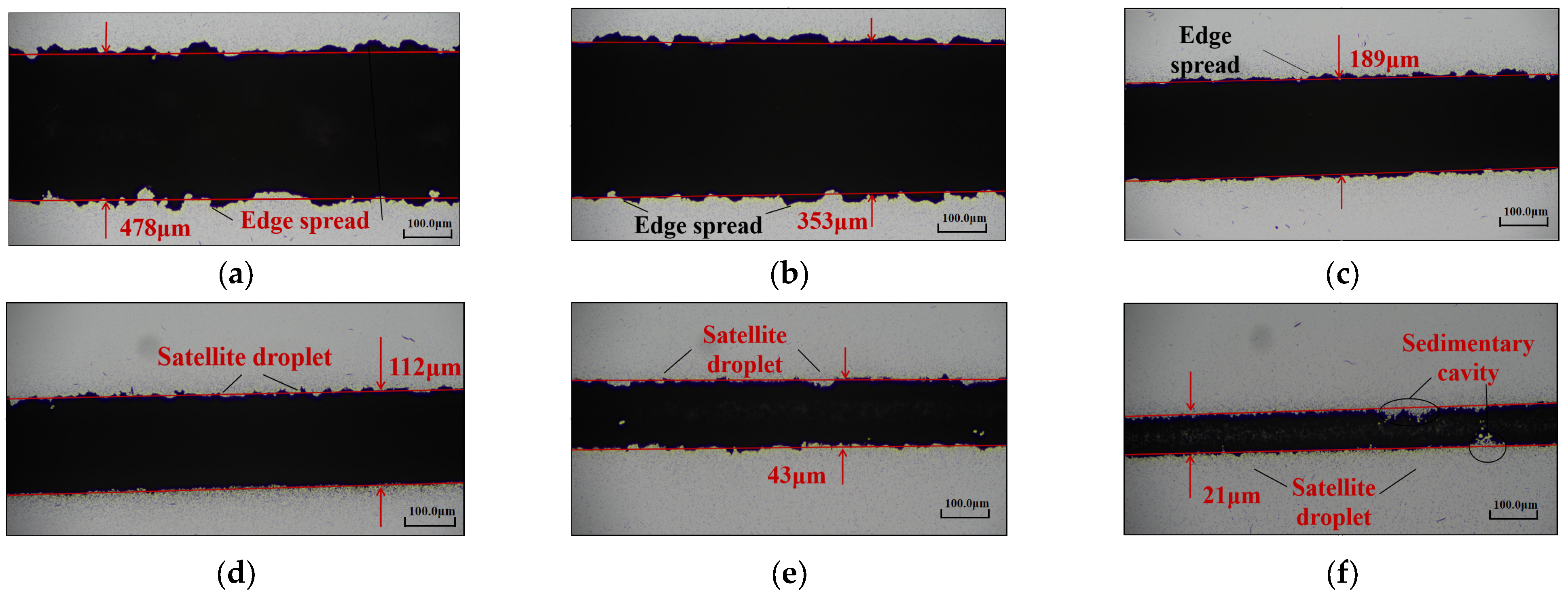
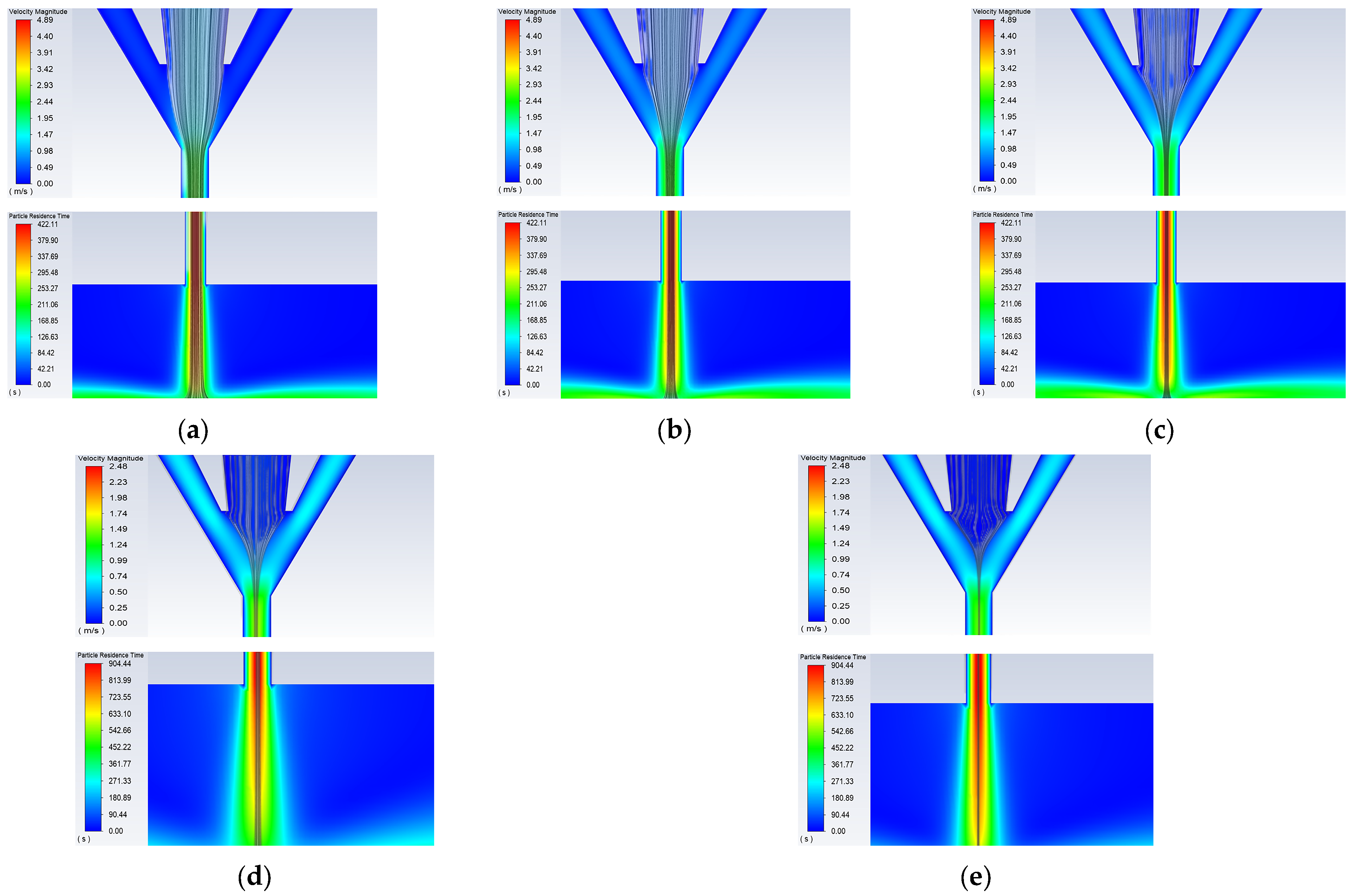
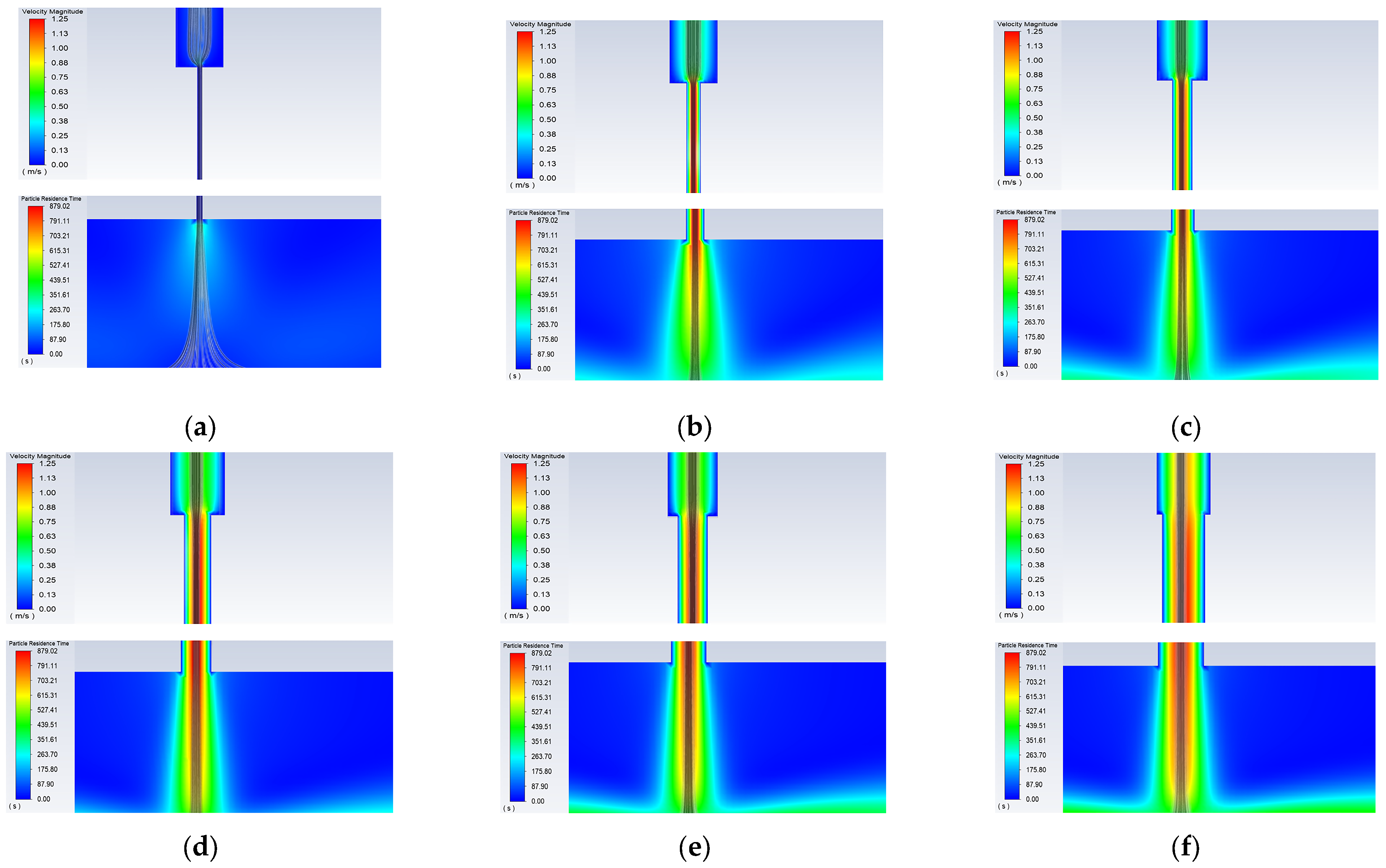
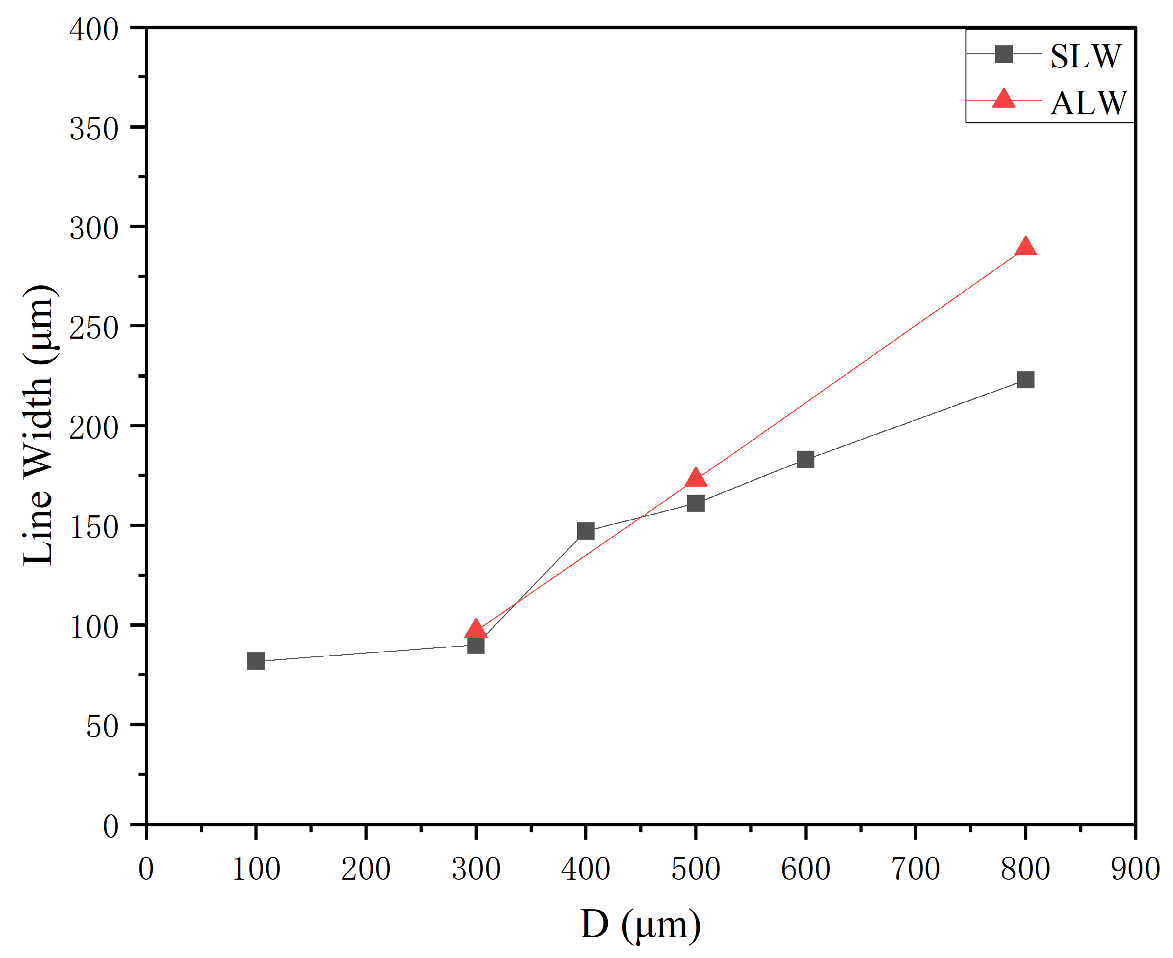


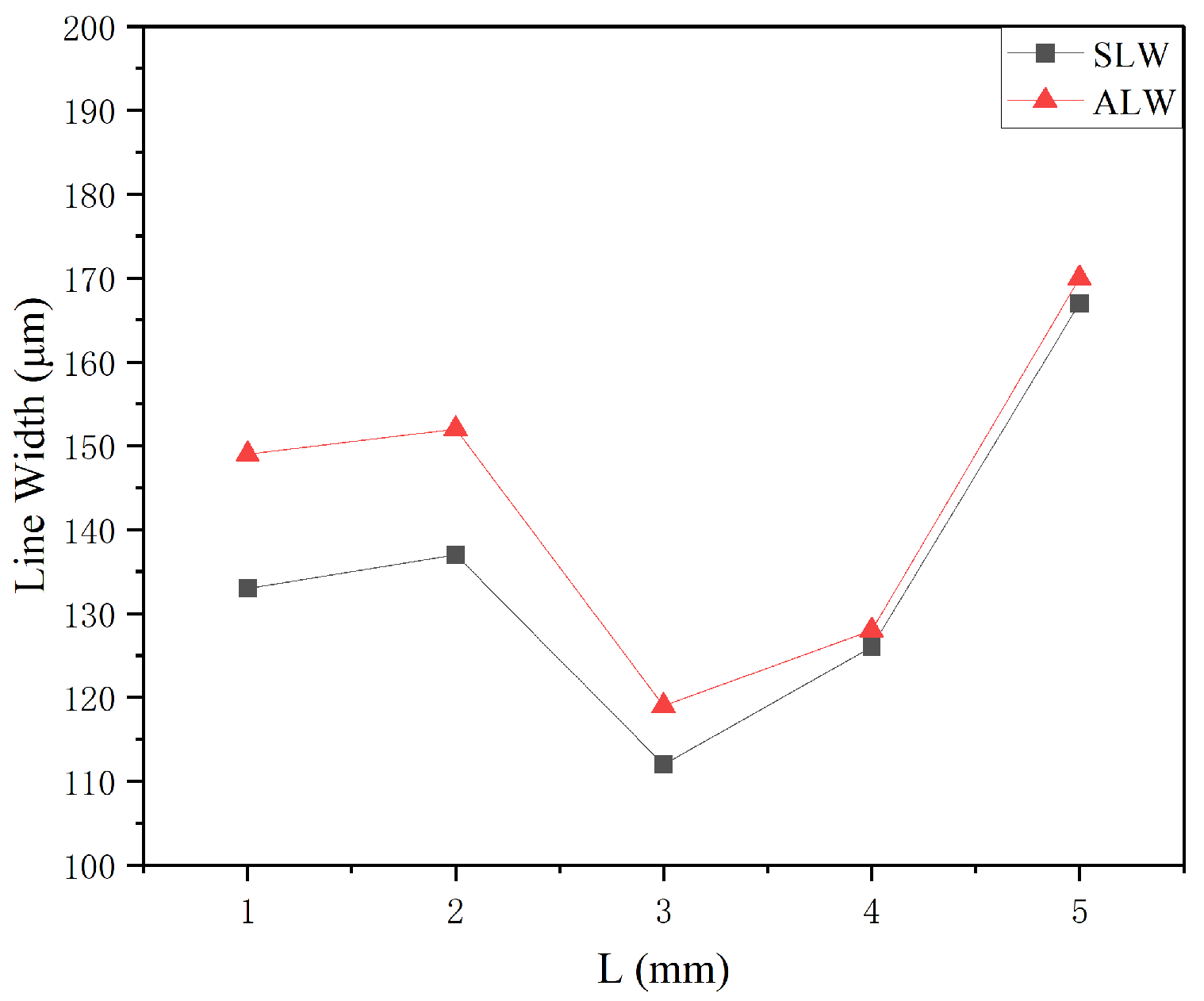
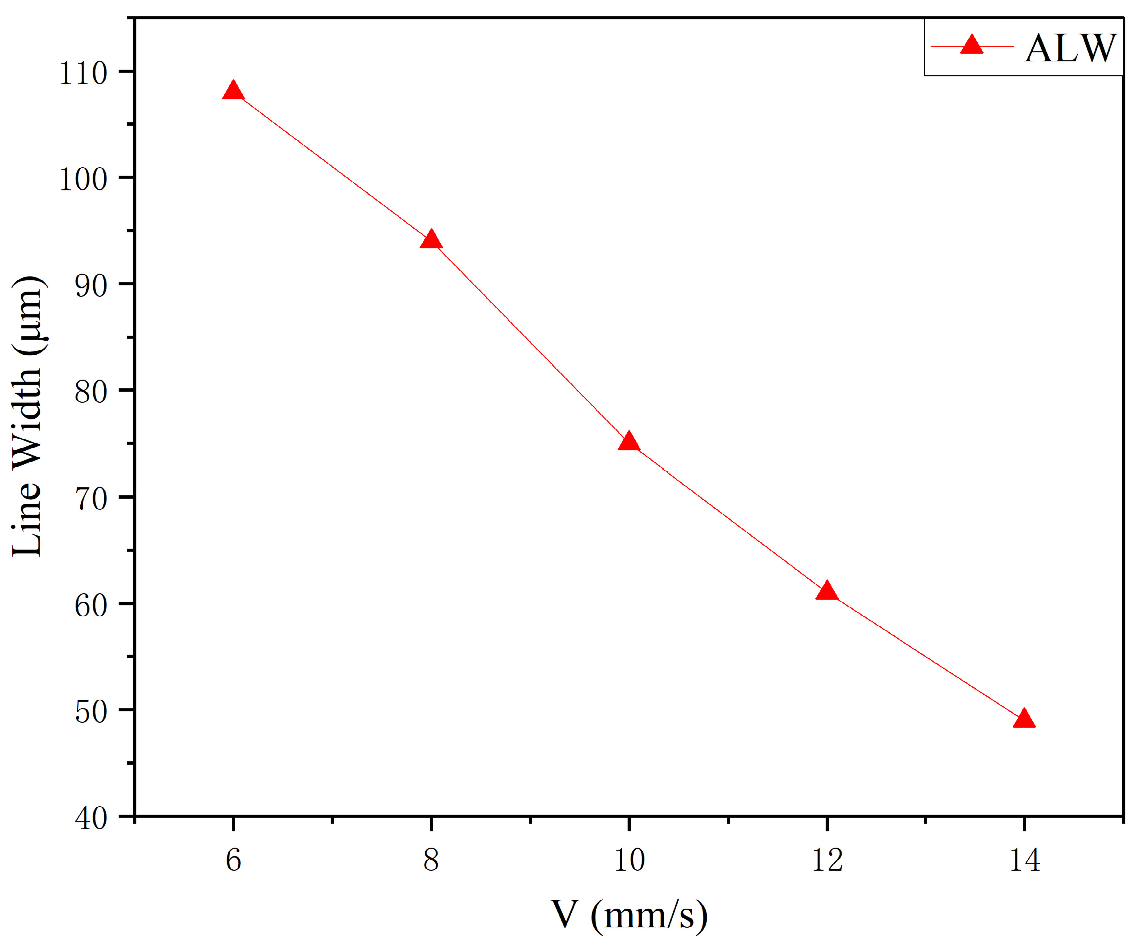
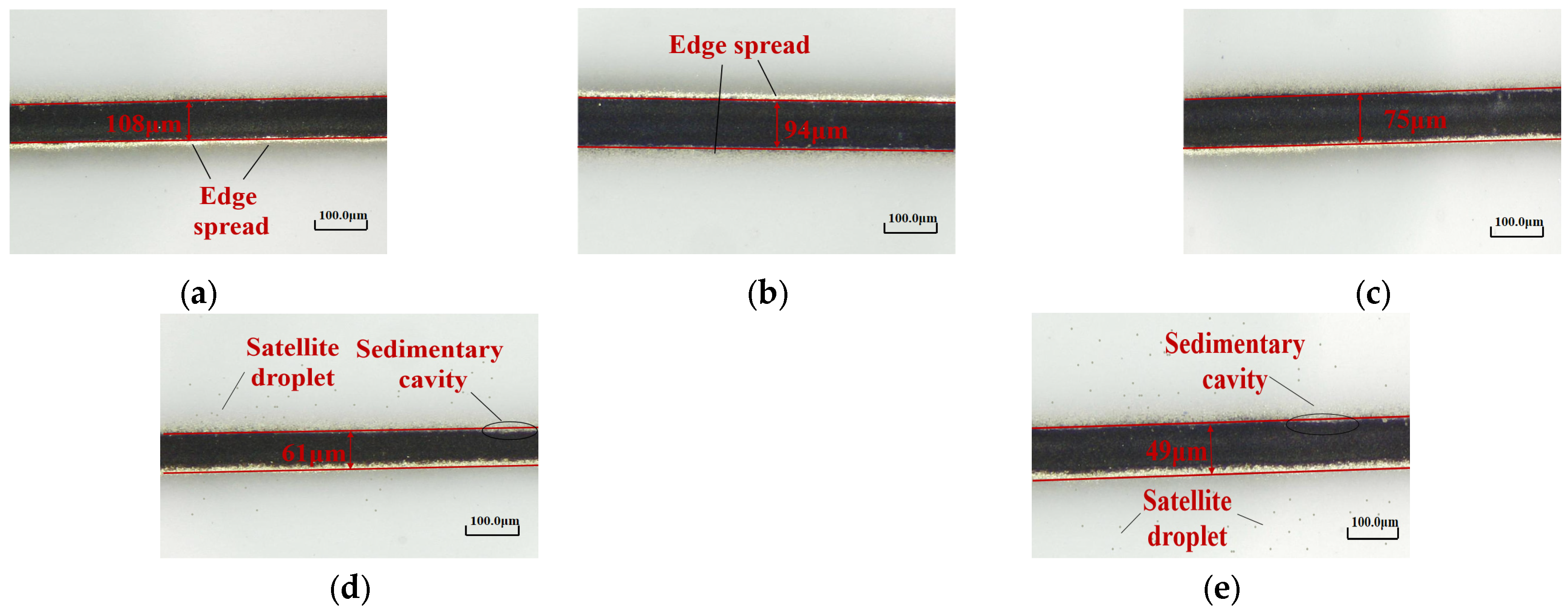

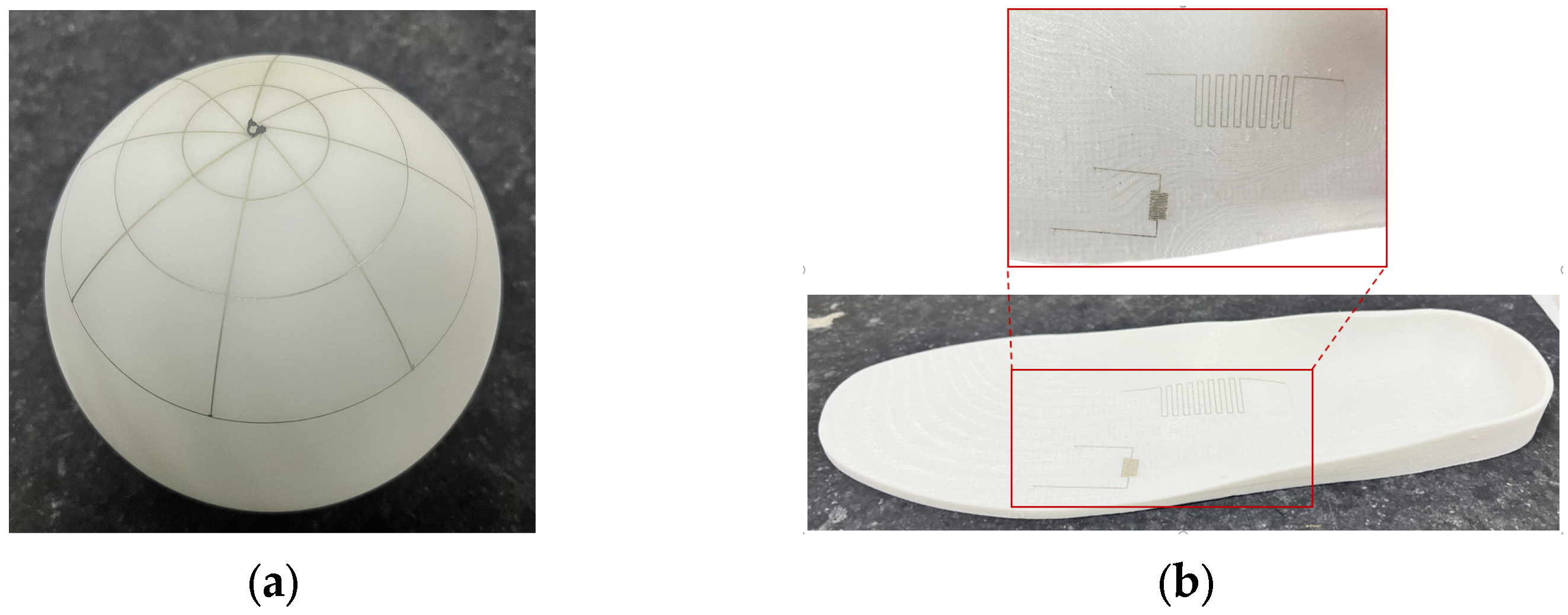

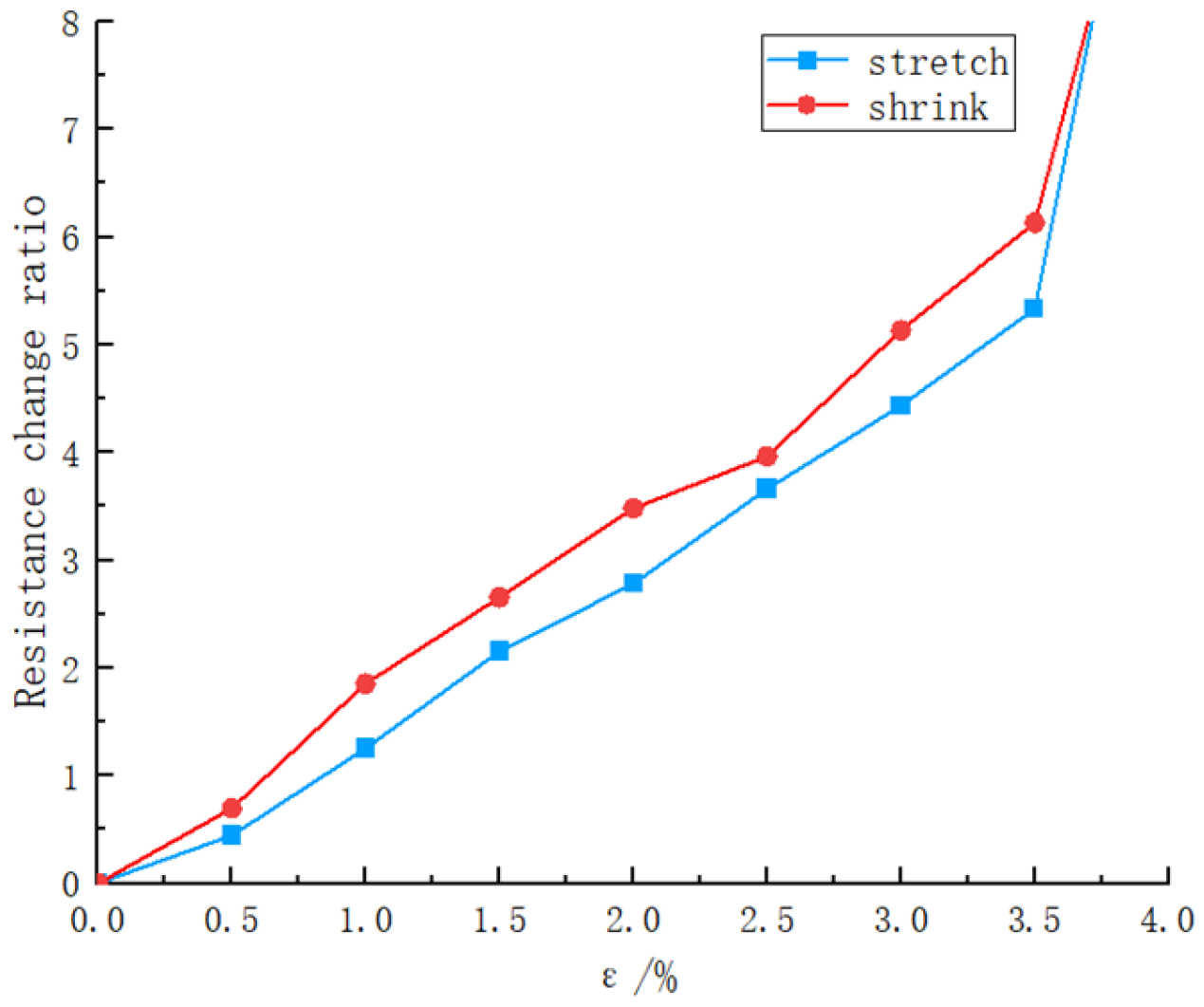
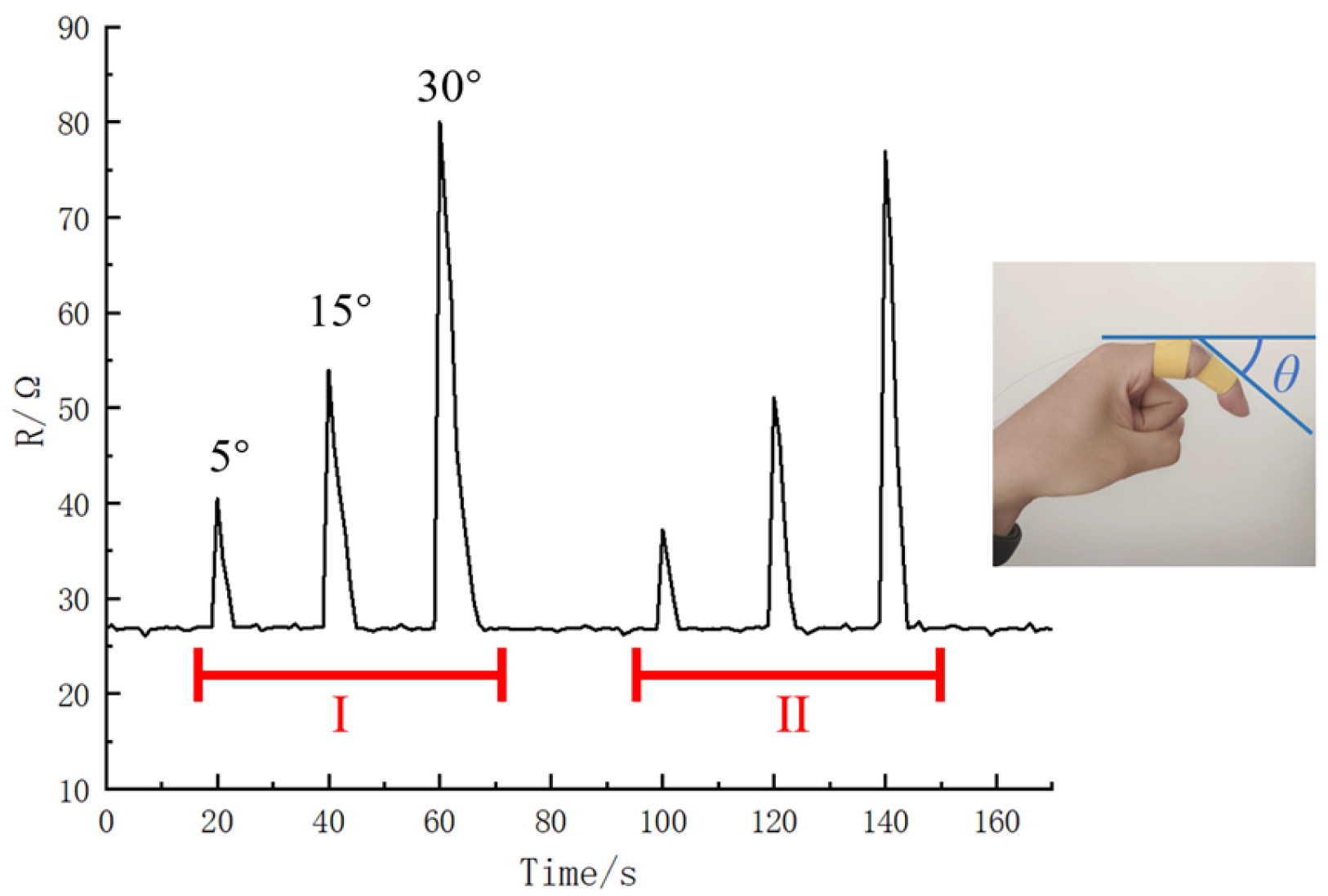
| X | L (mm) | D (μm) | V (mm/s) |
|---|---|---|---|
| 0.5 | 1 | 100 | 6 |
| 1 | 2 | 300 | 8 |
| 2 | 3 | 400 | 10 |
| 3 | 4 | 500 | 12 |
| 4 | 5 | 600 | 14 |
| 5 | 800 |
Disclaimer/Publisher’s Note: The statements, opinions and data contained in all publications are solely those of the individual author(s) and contributor(s) and not of MDPI and/or the editor(s). MDPI and/or the editor(s) disclaim responsibility for any injury to people or property resulting from any ideas, methods, instructions or products referred to in the content. |
© 2023 by the authors. Licensee MDPI, Basel, Switzerland. This article is an open access article distributed under the terms and conditions of the Creative Commons Attribution (CC BY) license (https://creativecommons.org/licenses/by/4.0/).
Share and Cite
Zhang, Y.; Zhu, T.; Jiao, J.; Song, S.; Wang, Z.; Wang, Z. Experimental and Numerical Investigation on the Aerosol Micro-Jet 3D Printing of Flexible Electronic Devices. Materials 2023, 16, 7099. https://doi.org/10.3390/ma16227099
Zhang Y, Zhu T, Jiao J, Song S, Wang Z, Wang Z. Experimental and Numerical Investigation on the Aerosol Micro-Jet 3D Printing of Flexible Electronic Devices. Materials. 2023; 16(22):7099. https://doi.org/10.3390/ma16227099
Chicago/Turabian StyleZhang, Yuanming, Tao Zhu, Junke Jiao, Shiyu Song, Zhenqian Wang, and Ziwen Wang. 2023. "Experimental and Numerical Investigation on the Aerosol Micro-Jet 3D Printing of Flexible Electronic Devices" Materials 16, no. 22: 7099. https://doi.org/10.3390/ma16227099





